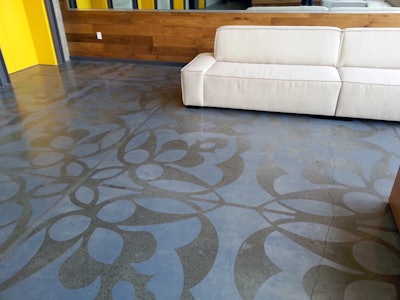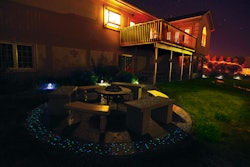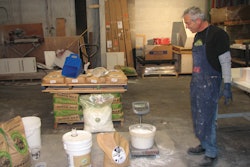
College living has evolved in recent decades. Gone are the days of twin beds, ramen noodles and drafty windows. Today’s students look for modern amenities, onsite dining, and the latest in construction design and technology.
When the owners of University House student apartments near the campus of Arizona State University in Tempe, Ariz., planned the construction of its new 19-story, state-of-the-art student housing high-rise, they knew they were under some pressure to create a comfortable and attractive space for potential renters. And because Arizona State University is home to the prestigious Ira A. Fulton Schools of Engineering and the Del E. Webb School of Construction, they also knew they needed to utilize the latest trends from the AEC world, including finishes and sustainable building methods.
Apartments include granite countertops, stainless steel appliances and floor-to-ceiling low E windows. When it came to floor coverings, University House chose a variety of options throughout the building, including carpet, tile and wood-style floors. For the lobby, the owners took a different approach. They needed something that was durable enough to hold up to foot traffic from hundreds of residents and their visitors and still provide a sophisticated, visual welcome. The owners settled on a decorative etched design on the concrete floors.
Flooring contractor Jeremy Thiede of CFS chose the Flattoo system from Surface Gel Tek for the etched design. The Flattoo system consists of a vinyl template and an acid etching gel that leaves a profile on the floor. After a series of jobsite mockups, the owners also chose a subtle gray stain to further enhance the design.
Building the template
Tamryn Doolan is president and CEO of Surface Gel Tek, Tempe, Ariz. She says the 1,200-square-foot Flattoo installation at University House is the largest Flattoo installation in the world to date.
The Flattoo covers the main lobby floor and reaches down two hallways. The design, which Doolan likens to a reverse fleur-de-lis, is made up of an 8-foot by 8-foot motif that repeats across the floor.
It took Doolan and her team nearly two weeks to build and organize the vinyl template for the University House installation. It consisted of 120 unique, numbered pieces. Doolan also supplied an installation key that instructed installers where and in what direction the pieces went on the floor. If one piece would have been out of order, it could have thrown off the entire design.
Doolan added a few details to her templates to ensure success on this project. First she included a ¼-inch overlap on each template piece. This eliminated any chance the gelled acid would seep through the cracks and cause unwanted etching where the templates met up. It also made it easy for installers to line up each template perfectly.
Another step she took to ensure success with the template installation was to build in a margin of error along walls and saw cuts. This made it easy for installers to cut pieces on the job to match variations in wall straightness and crack control saw cut widths.
“Instead of starting at a wall and working across, I made the templates line up with the saw cuts and worked toward the wall. People looking at a wall can’t tell if it’s off by 1/16 of an inch, but they can see when a design doesn’t line up with a saw cut,” Doolan explains.
Installation process
The installation contractor had an eight-man crew and two foremen on site. Because of Doolan’s proximity to the jobsite and the fact that this was Contract Flooring Solutions’ first Flattoo installation, Doolan offered training throughout the project.
The Flattoo installation happened toward the end of the construction process. The GC had adequate floor protection on the floor, but unfortunately brought up the floor protection too early. That resulted in scuff marks, tape lines, bucket rings and unidentifiable stains. “We needed to clean the floor, but could not etch or grind the surface to bring up those stains because that would have interfered with our etching process,” Doolan explains. The crew had to clean the floor the best it they could with water and a vacuum.
After the vinyl template was in place, the crew started the etching process. For the etch, Doolan recommended HD24 Pre Grind, Surface Gel Tek’s most aggressive gelled acid. Gelled acid contains an acid suspended in a gel. The acid reacts with the calcium, lime and salt in the concrete. The acid will not drop out of the gel unless it comes into contact with something it reacts with. That means it will not react with the vinyl template, or for that matter, human flesh.
The intricate design of the template left exposed concrete in small sections, the largest of which were only 5 inches wide. Crew members got down in on their hands and knees to rub scrub the gelled acid into the exposed concrete with 2-inch paint brushes.
“As we etched across the lobby floor, each worker had a designated area. I directed everyone to work a spot until there was no more sizzle; that’s when you know the product is expired and the floor has reached an 80-grit profile.” Doolan explains “The gelled acid only reacts when it is being worked into the surface and really doesn’t do much if just applied and left to sit undisturbed”. Once the crew members where finished with a section, they neutralized the gelled acid with water and moved on to the next section.
“When you etch concrete, the acid leaves both a visual and porosity change. The surface is no longer smooth and you can see and feel that the concrete is opened up,” Doolan explains. “The etched surface below is lighter than the top surface of the unetched concrete surface. That’s why it is important to always do a mockup for clients, so they can see that color change and how different stains work with the concrete.”
After the etch, crews crawled around the floor to ensure the vinyl Flattoo template was still securely adhered to the floor. “When you add a lot of water you can break that bond between the Flattoo and the concrete. We didn’t want the gray color to wick under the template and spread where we didn’t want it,” Doolan explains. “In places where you lose adhesion you can take a little acetone on a rag, wrap it around your finger and wipe down the edge to reactivate the adhesion. It’s a helpful trick.”
The etching process prepares the concrete to take a water-based color. “Acid stains burn into the floor through the top surface. Water-based colorants are dependent on the profile of the floor. If there was no profile, the water-based colors would just sit on top of the floor,” Doolan explains.
Crew members then applied the water-based acrylic gray color, let it dry and applied a second coat. “That second coat evened out the bucket rings and other flaws on the floor,” Doolan says. “All the imperfections on the floor just disappeared into the design.”
After the color dried, crews pulled up the vinyl template and vacuumed one more time to remove any dried color dust that came off the edges of the vinyl. Because of the water-based color, they couldn’t introduce water to clean the floor.
Crew members finished the job with a two-part epoxy urethane sealer with a satin finish. They used a high-quality lamb’s wool applicator to avoid roller marks you can sometimes get with a lesser quality applicator. “The sealer was also liquid enough that it self-levels a little bit,” Doolan explains.
The first sealer coat set for 5 hours. Then the crew applied a second coat.
Finished design
The process left the owners of University House with a long-lasting, durable, maintenance-friendly lobby that will hold up to years of foot traffic. The end product was the sustainable, sophisticated look they wanted for their high-end apartment building.
“The design is etched into the concrete. It will not fade or walk off. It’s not drawn on or sitting on the surface – it’s part of the concrete,” Doolan says.




















